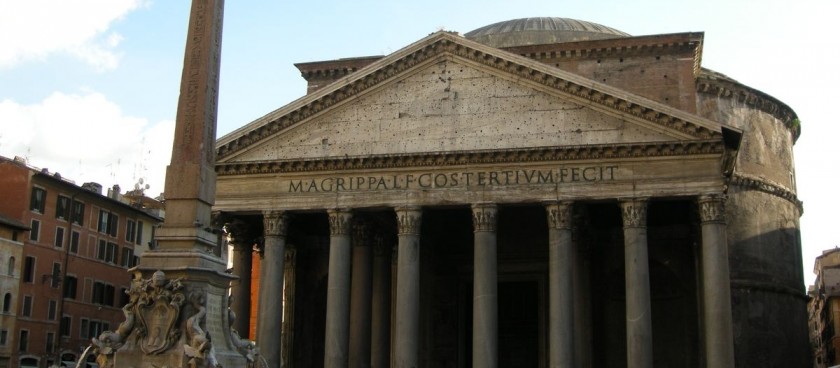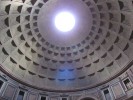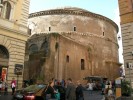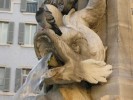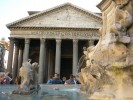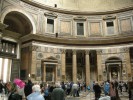- #IT06
- Piazza della Rotonda, Rome
- Working hours*:
Monday – Saturday: 9:00 - 18:30
Sunday: 9:00 - 13:00 - Prices*:
FREE - * - opening and closing times as well as entrance prices, are subject to alterations without notice. Visitors are advised to check before visiting.
- 41.8985950, 12.4768540 Copy to clipboard Copy
-
#History
As the brick stamps on the side of the building reveal it was built and dedicated between A.D 118 and 125.
The emperor Hadrian (A.D 117-138) built the Pantheon to replace Augustus’ friend and Commander Marcus Agrippa’s Pantheon of 27 B.C. which burnt to the ground in 80 A.D.
When approaching the front of the Pantheon one can see the inscription above still reads in Latin the original dedication by Marcus Agrippa. The inscription reads:
"M. AGRIPPA.L.F.COSTERTIUM.FECIT”
“Marcus Agrippa son of Lucius, having been consul three times made it”.
Despite all the marvelous building projects that the emperor Hadrian produced during his reign, he never inscribed his name to any, but one, the temple of his father Trajan. That is why the Roman Pantheon bears the inscription of Marcus Agrippa, and not the emperor Hadrian.
The pediment,(the triangle section above the inscription) is blank today, but there would have been sculpture that acted out the battle of the Titans. Great bronze doors guard the entrance to the cella and would have been covered in gold, but it has long since disappeared.
The original use of the Pantheon is somewhat unknown, except that is was classified as a temple. However, it is unknown as to how the people worshipped in the building, because the structure of the temple is so different from other traditional Roman temples such as in the Roman Forum.
The Pantheon exists today in such amazing form because the Byzantine emperor Phocas gave it to Pope Boniface the IV in A.D 608 and it was used as a church ever since. The Pantheon has been in use since the time it was built.
Architecture of the Pantheon
Probably one of the most fascinating features of the Pantheon is the Architecture. The structure of the Pantheon is comprised of a series of intersecting arches. The arches rest on eight piers which support eight round-headed arches which run through the drum from its inner to its outer face. The arches correspond to the eight bays on the floor level that house statues.
The dome itself is supported by a series of arches that run horizontally round. Romans had perfected the use of arches which helped sustain the weight of their magnanimous buildings.
The Romans were aware of the heavy nature of their building materials. So they used lighter materials toward the top of the dome. On the lowest level travertine, the heaviest material was used, then a mixture of travertine and tufa, then tufa and brick, then all brick was used around the drum section of the dome, and finally pumice, the lightest and most porous of materials on the ceiling of the dome.
This use of lighter materials on top alleviated the immense weight of the dome. The Roman Pantheon was probably constructed by using an elaborate setup of wooden scaffolding, which in itself would have been costly. The elegant coffers on the dome were likely struck with a device that was exacted from floor level.
The detail of this building is extraordinary. If the dome of the rotundra were flipped upside down it would fit perfectly inside the rotunda. When approaching the Pantheon from the outside it appears rectangular in shape. But it is only the first small room (cella) that has corners. The rotunda is completely round. The small entry room would have been entered by climbing a staircase that is now entirely under modern ground level.
Also, in antiquity there would have been a large colonnaded enclosure in front of the building making it almost impossible for one to glimpse the dome at the back.
The statues of Augustus and Agrippa stood in the apse at the end of the colonnaded side aisles of the entrance.
The interior design of the Roman Pantheon is a striking synthesis of tradition and innovation. The dimensions of the interior height and the diameter of the dome are the same (145 Roman feet., which is 141 feet. 8 inches;43.2m).
The architect, who is unknown, did this on purpose to show the harmony of the building. The marble veneer that we see today on the interior was for the most part added later.
However, the Roman Pantheon in its present state allows us a glimpse into the marvelous and stunning world of Roman architecture. The dome would have been gilded to look like the heavenly sphere of all the gods that the name Pantheon evokes. The oculus was an engineering gem of the Roman world. No oculus had even dared come close in size to the one in the Pantheon. It is still lined with the original Roman bronze and is the main source of light for the whole building. As the earth turns the light flows in to circle the interior making the viewer aware of the magnificence of the cosmos. The oculus was never covered and rain falls into the interior and runs off the slightly convex floor to the still functioning Roman drainpipes underneath. The Pantheon has since antiquity been used to inspire artists during the Renaissance as well as become the tomb for important figures in Italian history.
The Italian kings Vittorio Emanuele II and Umberto I as well as the famous Renaissance painter Raphael and his fiancée are buried in the Pantheon. It is a wonderful example of second century Roman architecture. It boasts mathematical genius and simple geometry that today still impresses architects and amazes the eyes of casual viewers.
